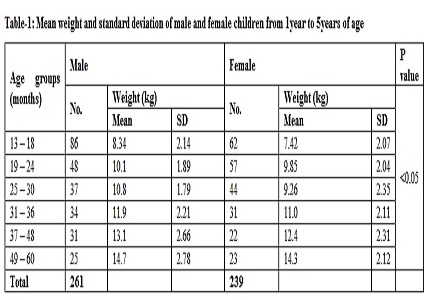Application of WHO MUAC for age -Z score chart in diagnosis of SAM in Indian children: a comparative study with IAP classification
Abstract
Background: Mid upper arm circumference (MUAC) is a quick and easy method to determine malnutrition. Though considered age independent earlier, recently World Health Organization (WHO) has prepared MUAC Z score chart for age group between 3 months to 5 years.
Objective: To diagnose severe acute malnutrition (SAM) by using new WHO MUAC-Z score and to compare its efficacy with IAP classification for the diagnosis of SAM.
Methods: A cross sectional study was conducted in a tertiary care center of north east India. 500 children in the age group of 1 to 5 years, attending inpatient department, were included and a detailed history, clinical examination and anthropometry were taken. SAM was defined by IAP weight for age classification as grade 3 and 4 and by WHO MAUC-Z score <-3SD.
Results: Prevalence of SAM according to IAP grading was 11.8% and according to WHO MUAC was 17% with difference being significant (p<0.05). The mean values of weight and MUAC were less than WHO median values which suggest that there is significant malnutrition in the study population. Prevalence of SAM was more in <2 years of age.
Conclusion: MUAC is more sensitive than IAP grading in early diagnosis of SAM and facilitate early and effective treatment. New WHO MUAC-Z score alone can be used in screening malnutrition.
Downloads
References
2. United Nations International Children’s Emergency Fund (UNICEF), the state of the world’s children, oxford university press, 0xford, 2005.
3. National Health and Nutrition Examination Survey – Anthropometric procedure Manual; CDC, January 2007.
4. Anthropometry Guideline Paediatrics [Internet]. 2016 [cited 10 July 2016]. Available from: http://www.adsa.org.za/Portals/14/Documents/Clinical20Guideline20Anthropometry.pdf
5. WHO | Arm circumference-for-age [Internet]. Who.int. 2016 [cited 10 July 2016]. Available from: http://www.who.int/childgrowth/standards/ac_for_age/en/
6. South Asia - India: Malnutrition Report [Internet]. Web.worldbank.org. 2016 [cited 10 July 2016]. Available from: "World Bank Report". Source: The World Bank (2009). World Bank Report on Malnutrition in India.
7. Ighogboja SI. Some factors contributing to protein-energy malnutrition in the middle belt of Nigeria. East African medical journal. 1992 Oct.;69(10):566-71. [PubMed]
8. Bhattacharya AK. Studies on Kwashiorkor and Marasmus in Calcutta (1957 – 74) – Aetiology and Clinical studies. Indian Pediatrics. 1975 Nov.;12(11):1103 - 13. [PubMed]
9. Guideline: Updates on the Management of Severe Acute Malnutrition in Infants and Children.Geneva: World Health Organization; 2013. [PubMed]
10. Roberfroid D, Hammami N, Lachat C, Prinzo ZW, Sibson V, Guesdon B, Goosens S, Kolsteren P. Utilization of mid-upper arm circumference versus weight-for-height in nutritional rehabilitation programmes: a systematic review of evidence. Geneva: World Health Organization. 2013 Oct.
11. Goossens S, Bekele Y, Yun O, Harczi G, Ouannes M, Shepherd S. Mid-Upper Arm Circumference Based Nutrition Programming: Evidence for a New Approach in Regions with High Burden of Acute Malnutrition. PLoS ONE. 2012;7(11):e49320. [PubMed]
12. Briend A, Maire B, Fontaine O, Garenne M. Mid-upper arm circumference and weight-for-height to identify high-risk malnourished under-five children. Maternal & Child Nutrition. 2011;8(1):130-133. [PubMed]
13. Powell-Tuck J. A comparison of mid upper arm circumference, body mass index and weight loss as indices of undernutrition in acutely hospitalized patients. Clinical Nutrition. 2003;22(3):307-312.

Copyright (c) 2016 Author (s). Published by Siddharth Health Research and Social Welfare Society

This work is licensed under a Creative Commons Attribution 4.0 International License.


 OAI - Open Archives Initiative
OAI - Open Archives Initiative


